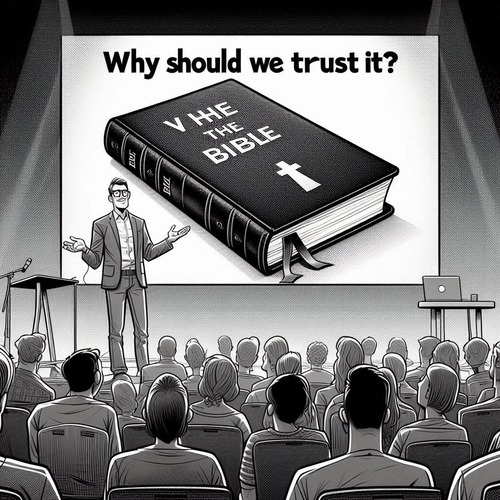Historicity of Adam & Eve: The New Testament’s Validation
In an age where many dismiss Adam and Eve as mere myth or allegory, the question arises: how did the New Testament (NT) authors view our first parents? The evidence is striking and consistent—Jesus and the apostles repeatedly affirmed Adam and Eve as historical individuals whose actions shaped human history. This affirmation appears not as peripheral commentary but as foundational to core Christian doctrines.
JESUS CHRIST VALIDATES THE CREATION ACCOUNT
Jesus Himself referred to Adam and Eve as historical persons. In addressing questions about marriage and divorce, Jesus stated: “Have you not read that He who created them from the beginning made them male and female, and said, ‘Therefore a man shall leave his father and his mother and hold fast to his wife, and the two shall become one flesh’?” (Matthew 19:4-5)
Jesus directly quotes Genesis 2:24, treating the creation account as historically reliable. In Mark’s parallel account (Mark 10:6-8), Jesus again anchors His teaching on marriage in the historical creation of Adam and Eve. Notably, Jesus doesn’t present these references as metaphorical or allegorical but as factual events that establish the foundation for marriage.
PAUL’S THEOLOGICAL FRAMEWORK REQUIRES HISTORICAL ADAM & EVE
The Apostle Paul’s theological arguments collapse without a historical Adam and Eve. Consider these key passages:
Romans 5:12-19—Sin Through One Man Paul’s entire explanation of sin and redemption hinges on Adam being a real person (Romans 5:12).
Paul constructs a parallel between Adam and Christ: “For as by the one man’s disobedience the many were made sinners, so by the one man’s obedience the many will be made righteous” (Romans 5:19). This comparison loses all logical and theological coherence if Adam wasn’t a real historical figure whose actions had genuine consequences.
1 Corinthians 15:21-22, 45-49—The First and Last Adam Paul writes: “For as by a man came death, by a man has come also the resurrection of the dead. For as in Adam all die, so also in Christ shall all be made alive” (1 Corinthians 15:21-22).
Later in the same chapter, Paul elaborates: “Thus it is written, ‘The first man Adam became a living being’; the last Adam became a life-giving spirit” (1 Corinthians 15:45). Paul refers to Genesis as authoritative history, not allegory, and builds his resurrection theology on the historical reality of both Adam and Christ.
1 Timothy 2:13-14—The Order of Creation and Fall In discussing church roles, Paul references the creation order and fall as historical facts: “For Adam was formed first, then Eve; and Adam was not deceived, but the woman was deceived and became a transgressor.” (1 Timothy 2:13-14)
Paul’s argument makes no sense if Adam and Eve are merely symbolic. He bases practical church instruction on the historical sequence of creation and fall—demonstrating his complete confidence in Genesis as accurate history.
OTHER APOSTOLIC WITNESSES TO ADAM & EVE’S HISTORICITY
- Luke’s Genealogy—Luke 3:23-38 Luke traces Jesus’s genealogy all the way back to Adam (Luke 3:38). Luke, the careful historian, includes Adam in the same genealogical list as verified historical figures. He makes no distinction between Adam and historical figures like David or Abraham—all are treated as real ancestors of Jesus.
- Jude’s Reference—Jude 14 Jude refers to Enoch as “the seventh from Adam,” treating Adam as the first in a historical lineage. This casual reference demonstrates Jude’s assumption that his readers understood Adam as a historical person.
- Paul’s Warning—2 Corinthians 11:3: Paul references Eve’s deception as a real historical event, using it as a warning to the Corinthian church. This warning loses its power if Eve’s deception was merely fictional.
THEOLOGICAL IMPLICATIONS
The NT’s consistent witness to Adam and Eve’s historicity carries profound theological implications:
- Original Sin—The doctrine of original sin depends on a historical Adam whose sin had real consequences for humanity.
- Christ as Redeemer—Jesus as the “second Adam” requires a real “first Adam” for theological coherence. The parallel breaks down if one term is historical and the other mythical.
- Gospel Foundation—The gospel message itself—that Christ came to reverse the effects of the fall—relies on the historicity of that fall.
- Biblical Authority—If Adam and Eve were not historical despite the New Testament’s clear affirmation, it undermines confidence in Scripture’s reliability on other matters.
CONCLUSION
HISTORICITY OF ADAM & EVE: The NT evidence is clear and consistent—Jesus and the apostles considered Adam and Eve to be real historical figures whose actions had profound consequences for humanity. They referenced Adam and Eve not as literary devices but as actual people whose existence and actions formed the foundation for essential Christian doctrines.
The historical Adam and Eve serve as the starting point for the biblical narrative of fall and redemption. The NT authors understood the narrative not as helpful mythology but as actual history—a history that explains our present human condition and points to our need for Christ, the second Adam who came to restore what was lost through the first.
For the Christian seeking to understand Scripture as the NT authors did, accepting the historicity of Adam and Eve isn’t optional—it’s essential to maintaining the coherence of the gospel message itself.
HISTORICITY OF ADAM & EVE: RELATED FAQs
Do any NT passages suggest Adam and Eve might be allegorical rather than historical? No NT passage presents Adam and Eve as allegorical figures. While Paul occasionally uses allegory (as in Galatians 4 with Sarah and Hagar), he explicitly states when he’s employing allegory. In every reference to Adam and Eve, the NT authors present them as historical individuals whose actions had real consequences for humanity.
- How do contemporary Reformed scholars defend Adam and Eve’s historicity? Michael Kruger, Kevin DeYoung, and Albert Mohler emphasise the NT’s theological arguments require a historical Adam and Eve. They point to the doctrine of federal headship—where Adam represented all humanity—as essential to understanding sin and salvation. Additionally, they argue the genealogies connecting Adam to Jesus and Paul’s Adam-Christ typology break down without a historical first couple.
- What about Christians who accept evolutionary science but still affirm biblical authority? Some evangelical scholars like John Walton, C John Collins, and Denis Alexander propose models that maintain a historical Adam and Eve while accommodating scientific evidence. These models include viewing Adam and Eve as the first spiritually aware humans (though not necessarily the first biological humans), as representatives of early humanity, or as a specially created couple placed among existing hominids. These scholars still affirm the theological necessity of a historical Adam and Eve while interpreting Genesis in light of ancient Near Eastern literary contexts.
Does the NT distinguish between the historical reliability of Adam versus other Old Testament figures? The NT makes no distinction between the historical reality of Adam and other Old Testament figures such as Noah, Abraham, or Moses. Jesus and the apostles refer to all these individuals with the same historical assumption, often in the same passages or arguments. This consistent treatment suggests the NT authors viewed the entire biblical narrative as historically reliable, from Adam onward.
- How does Paul’s use of Adam in 1 Corinthians 15 specifically support historicity? In 1 Corinthians 15, Paul’s resurrection argument depends entirely on Adam’s historicity when he states, “For as in Adam all die, so in Christ all will be made alive.” Paul quotes Genesis 2:7 directly and calls Adam “the first man” in contrast to Christ as “the last Adam.” If Adam were merely symbolic, Paul’s entire argument about physical and spiritual bodies would collapse, as would his parallel between the historical reality of Adam’s action and Christ’s resurrection.
- What implications does Adam and Eve’s historicity have for the doctrine of Scripture’s inerrancy? For those who hold to Scripture’s inerrancy, the NT’s clear affirmation of Adam and Eve as historical figures becomes determinative. If Jesus and the apostles were mistaken about Adam and Eve’s historicity while presenting them as historical, it would undermine confidence in their teaching on other matters. Most inerrancy proponents thus argue the NT’s consistent historical treatment of Adam and Eve should guide our interpretation of Genesis.
How do NT references to Eve specifically support her historicity? Eve receives fewer explicit mentions in the New Testament than Adam, but each reference treats her as historical. Paul notes her creation after Adam in 1 Timothy 2:13 and refers to her deception by the serpent in 2 Corinthians 11:3. These references incorporate specific details from Genesis rather than general principles, indicating Paul understood these as actual historical events involving a real woman named Eve.
HISTORICITY OF ADAM & EVE: OUR RELATED POSTS
Editor’s Pick

Testament to Design: The Engineering Marvel of Elephants
Picture an African elephant delicately plucking a single acacia leaf with the tip of its trunk, then moments later using [...]

Blue Whales: Mammoth Icons of Intelligent Design
Imagine an animal so massive its heart alone weighs as much as a small car, yet so precisely engineered it [...]

Do Unbelieving Kids Disqualify Church Leaders?
REFORMED PERSPECTIVES ON 1 TIMOTHY 3 AND ELDER QUALIFICATIONS Every pastor knows the heartbreak. A faithful elder who has served [...]

Why Did God Kill Onan? Wasn’t the Punishment Disproportionate?
The story of Onan in Genesis 38 troubles many. Why would God strike down a man for what seems like [...]

Is God Preparing Me for Ministry? How May I Know for Sure?
The question haunts many faithful believers. You’re serving faithfully in your local church, perhaps teaching Sunday school or leading a [...]

Ephesians 1:13: Was the Spirit’s Indwelling Promised of Old?
When Paul declares believers are “sealed with the promised Holy Spirit” in Ephesians 1:13, one word jumps off the page: [...]

Monergism vs Synergism: Is Salvation God’s Work Alone?
When God saves us, does He do it alone, or does He need our help? The question isn’t mere theological [...]

Was Jesus Abandoned by the Father on the Cross?
WHY WE ANSWER IN THE NEGATIVE “My God, my God, why have you forsaken me?” These words from the cross [...]

Why Do Some Respond to God’s Call While Others Don’t?
THE REFORMED VIEW ON OUTWARD AND INWARD CALLS EXPLAINED Picture this: Two neighbours attend the same church service. They hear [...]

Does Ocean Salt Content Prove a Young Earth?
A COMPELLING LOOK AT MARINE CHEMISTRY AND EARTH’S TIMELINE The Salt Question That Challenges Deep Time: If Earth’s oceans have [...]





